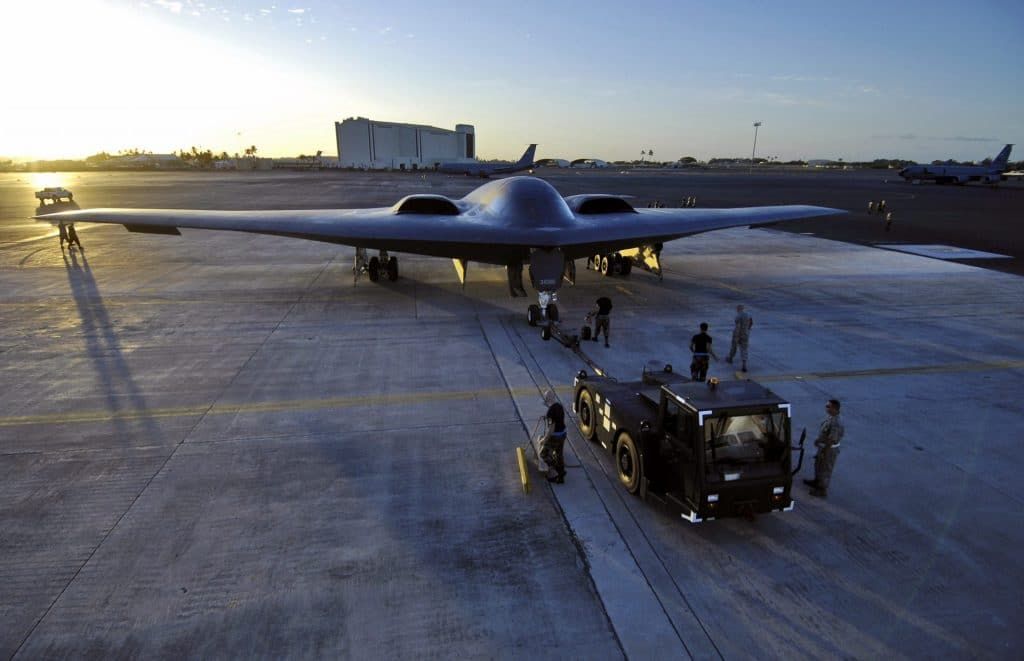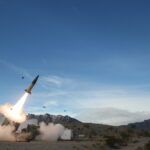Debating US nuclear spending in the age of the coronavirus
By Kingston Reif | June 10, 2020
 A B-2 Spirit stealth bomber, 2013. Photo credit: Tech. Sgt. Shane A. Cuomo for US Defense Department.
A B-2 Spirit stealth bomber, 2013. Photo credit: Tech. Sgt. Shane A. Cuomo for US Defense Department.
As the novel coronavirus pandemic continues to exact a terrible human and economic toll on the United States, Americans are adjusting how they view national security. There also appears to be agreement, even within the senior leadership of the Defense Department, that the military budget, which has seen significant growth during the Trump administration, is likely to be pared back in the coming years as federal deficits soar.
So it should be no surprise that the havoc wrought by the virus has also fanned the flames of an ongoing debate about the Trump administration’s aggressive and costly plans to sustain and upgrade the US nuclear arsenal.
But some supporters of the status quo will not countenance any challenge to business as usual. In an April 17 conversation hosted by the Mitchell Institute for Aerospace Studies, Frank Miller, a distinguished former US government official, argued that it is illegitimate and irresponsible to cite the current public health and economic crisis as a rationale to rethink US nuclear weapons spending priorities. A close examination reveals, however, that his reasoning is deeply flawed.
The unsustainable nuclear budget. At the Arms Control Association, where I am the director for disarmament and threat reduction policy, we have long argued that the administration’s approach is unnecessary, unsustainable, and unsafe. The financial and opportunity costs have steadily grown and the biggest nuclear weapons modernization bills are just beginning to arrive. Government officials in charge of the nuclear weapons enterprise warn about the “pervasive and overwhelming risk” facing the current nuclear modernization program.
The danger posed by the plans is on full display in the administration’s fiscal year 2021 budget request.
The Defense and Energy Departments are requesting $44.5 billion for next year to sustain and modernize US nuclear delivery systems and warheads and their supporting infrastructure, a larger-than-anticipated increase of about $7.3 billion, or 19 percent, from the fiscal year 2020 level. Meanwhile, the administration is recommending a lower overall national defense budget than Congress provided last year.
The combination of a decreased topline budget but an increased nuclear budget means that other defense programs would have to be cut. Some programs on the chopping block include the Navy’s planned second Virginia class submarine, the Energy Department’s efforts to clean up nuclear waste leftover from US nuclear weapons production during the Cold War, and the Pentagon’s Cooperative Threat Reduction program, which supports global efforts to detect and secure dangerous pathogens such as the coronavirus.
And this was all before the coronavirus began its deadly march across the country and before Congress spent several trillion dollars trying to save the US economy from complete collapse.
Although Pentagon officials insist that nuclear weapons should be shielded from possible future defense budget cuts, the pressure on the federal budget imposed by the response to the virus is likely to exacerbate the affordability and execution challenges confronting the administration’s nuclear spending plans. If great power competition with China is the Pentagon’s top priority, is it prudent to sacrifice a Virginia class submarine every year for the next 10 to 15 years to attempt to keep an excessive and overburdened nuclear modernization effort on track? The answer should be no, especially in light of the quantitative and qualitative superiority of the US nuclear arsenal over China’s.
In the view of many, the Trump administration’s proposal to expand spending on nuclear weapons is a sad and dangerous illustration of wildly misplaced federal spending priorities. As it proposed a 19 percent increase for nuclear weapons next year, the White House initially planned to slash the budgets for the Centers for Disease Control by 19 percent and the National Institutes of Health by 7 percent. The Pentagon’s proposal to cut the budget for the Cooperative Threat Reduction program in order to fund weapons modernization amid a global pandemic is shockingly reckless.
“How can we prepare and arm ourselves so completely for wars that may never come,” wrote Tyler Rogoway, editor of The Drive, in March, “but we are so ill-prepared for one that we knew was more likely around the corner than not?”
Inexplicably, the unprecedented economic crisis facing the nation hasn’t stopped some Trump administration officials from raising the prospect of even greater spending on nuclear weapons above and beyond what is already planned. Marshall Billingslea, President Trump’s special envoy for arms control, said recently that if Russia and China don’t agree to US demands for talks on new trilateral arms control to replace the 2010 New Strategic Arms Reduction Treaty (New START), Washington could win a new arms race if necessary. “We know how to win these races, and we know how to spend the adversary into oblivion,” he said.
More US spending on nuclear weapons won’t force the current Russian and Chinese leadership to capitulate and would be fraught with peril. The administration’s desire to pursue a more ambitious arms control agreement is the right goal, but it can’t be achieved before New START is slated to expire next February. A new quantitative arms race that could follow the collapse of New START would further undermine stability between the United States and Russia, the health of the global nonproliferation regime, and the US military’s emphasis on competition with China.
Our new post-pandemic reality should make it all the more obvious that the current modernization plans need to be reconsidered in a way that eliminates the most excessive and destabilizing elements, saves taxpayer dollars for other pressing national and health security needs, and is in sync with a revitalized and realistic strategy to cap and reduce global nuclear stockpiles.
A debate on nuclear weapons policy. In an article published on the Arms Control Association website in March, Shannon Bugos and I criticized the 2021 budget request for nuclear weapons and made the case for a different approach. The critique apparently struck a nerve with supporters of the Trump plans.
In his remarks for the Mitchell Institute event, Miller alleged that our organization is part of a nefarious disarmament cabal and attempted a point-by-point rebuttal of the purported “body of lies” and “dangerous recommendations” contained in our article. He claimed that our critique “comes from a group of people who have never felt the burden of public responsibility and public office in defense of this nation and our allies.” (In reality, nearly half of the Arms Control Association’s 17-member board of directors has served in government in some capacity, including several board members who have served at the Defense Department.)
Miller published an expanded version of his remarks earlier this month in Real Clear Defense.
But a review of what we actually wrote reveals that Miller either did not read our article or deliberately chose to distort its contents. Below I respond to each of his assertions.
The growing costs. Miller’s claim: “The projected cost of the [nuclear] modernization program as a percentage of the defense budget is not growing.”
Response: The projected cost of nuclear weapons, both in actual dollars and as a percentage of the national defense budget, is clearly growing, and doing so more quickly than anticipated.
The Pentagon request for 2021 of $28.9 billion to sustain and modernize the triad of nuclear delivery systems and supporting command and control infrastructure is a large increase above this year’s appropriated level of $24.8 billion. As we noted, the requested amounts are consistent with the projected spending levels for these programs contained in previous budget submissions.
The request for the semiautonomous National Nuclear Security Administration nuclear weapons program, however, is far larger than anticipated. The submission calls for $15.6 billion, an astonishing increase of $3.1 billion, or 25 percent, above the fiscal 2020 appropriation, and $2.8 billion more than the projection for 2021 contained in the fiscal year 2020 budget request. Over the next five years, the National Nuclear Security Administration is planning to request over $81 billion for weapons activities, a nearly 24 percent increase over what it planned to seek over the same period as of last year.
Miller, echoing arguments often made by Pentagon officials, claims that even at its projected peak in 2029, spending on nuclear weapons will consume no more than 6 to 7 percent of total Pentagon spending. But this is misleading, unless you think a credible deterrent can be maintained without having actual warheads.
The 6 to 7 percent figure doesn’t include spending at the National Nuclear Security Administration. When that is included, nuclear weapons already account for 6 percent of the total 2021 national defense budget request and will rise to 7 percent by 2024. Given the rate at which that agency’s budget is exploding, probable future cost overruns in the delivery system modernization programs, and the likelihood of flat overall defense budgets (at best) for the foreseeable future, it is conceivable that spending on nuclear weapons could approach 10 percent of national defense spending by the late 2020s.
Miller can claim that the growing modernization bill is worth the price. But he can’t claim that the price tag isn’t growing.
A bigger stockpile. Miller’s claim: “You can search the 2018 [Nuclear Posture Review] from cover to cover without finding any policy which supports expanding the US nuclear warhead stockpile.”
Response: It is true that the Trump administration is not currently planning to grow the size of the arsenal. But we never claimed otherwise. Instead, the 2018 Nuclear Posture Review contains several proposed initiatives that support preparing the United States to grow the size of the stockpile in the event of a future decision to do so. Examples include: providing “the enduring capability and capacity to produce plutonium pits at a rate of no fewer than 80 pits per year by 2030”; exploring “approaches for rapid [warhead] prototyping”; assessing “the potential for retired warheads and components to augment the future hedge stockpile”; and reducing “the time required to design, develop, and initially produce a warhead, from a decision to enter full-scale development.”
According to Madelyn Creedon, former deputy administrator at the National Nuclear Security Administration during the Obama administration, the Nuclear Posture Review “lays out a long-term plan to prepare the United States to develop, test, and deploy new nuclear weapons and to increase the size of the nuclear stockpile. In short, prepare for a new arms race.”
The National Nuclear Security Administration’s needs. Miller’s claim: “There should be no cause for uncertainty about the crying need for increased funding for [the National Nuclear Security Administration].”
Response: For 2021, the National Nuclear Security Administration has requested a large unplanned increase, totaling $15.6 billion for weapons activities. To many, such an increase was surprising: The agency said only last year that its 2020 budget plan was “fully consistent” with the 2018 Nuclear Posture Review and “affordable and executable.” Under that proposal, the agency did not plan to request more than $15 billion for weapons activities until 2030!
So, what changed? Lisa Gordon Hagerty, head of the National Nuclear Security Administration, was asked to explain the rationale for such a large unplanned increase at a Congressional hearing in March, but her attempt at an answer hardly cleared up the situation. Perhaps there is a clearer explanation for why the agency so badly misjudged its funding needs for 2021, but if so the agency has yet to provide it.
Plutonium pit production. Miller’s claim: “The comment that building 80 pits per year is unprecedented just doesn’t even work within their own circles.”
Response: At no point did we claim that the National Nuclear Security Administration’s effort to build at least 80 pits per year is unprecedented. What we actually wrote, citing an Institute for Defense Analyses report published last year, is that there is “no historical precedent” for the agency’s plan to go from the current production level of zero pits per year to 80 pits per year by 2030. The Institute for Defense Analyses report could not be clearer: “No available option can be expected to provide 80 pits per year by 2030.”
The right size for the arsenal. Miller’s claim: “It’s also absurd in the extreme … to argue that the size of the current arsenal is more than is required for deterrence.”
Response: It’s not at all absurd to argue that the size of the current US nuclear arsenal is more than is required for deterrence of adversaries and assurance of allies.
In 2013, the Obama administration determined that deterrence requirements could be met with one-third fewer deployed New START-accountable strategic nuclear forces. Yet Obama did not immediately reduce the size of America’s nuclear force, despite concluding that deterrence could be achieved by even a unilateral reduction.
Miller is of course free to argue that further reductions in the arsenal should only occur bilaterally with Russia (or trilaterally with Russia and China) or that the current security environment is such that further reductions aren’t advisable. But in that case the burden of proof is on him to explain the logic that presumes Moscow and Beijing would not be deterred by 1,000 nuclear warheads deployed on hundreds of delivery systems but are deterred by the 1,550 warheads deployed today.
The burden is also on him to explain why the current modernization plans should be funded next year at the expense of the Navy’s conventional shipbuilding account, defense environmental cleanup, and the Cooperative Threat Reduction program—and likely at the expense of similar such cuts in future years. A Virginia class submarine would seem to be far more relevant to great power competition with China than a one-year increase in funds for an agency that said last year it didn’t need those funds and is unlikely to be able to spend them.
Nuclear war fighting. Miller’s claim: “There is that old canard, the ever-popular bloody flag that US policy is based on nuclear war fighting, not on deterrence.”
Response: In our article and elsewhere we advocate for a nuclear strategy that deemphasizes nuclear war fighting by opposing the Trump administration’s proposal to double the number of low-yield nuclear options in the US nuclear arsenal. Miller and other supporters of expanding the number of such options claim that doing so would strengthen deterrence and raise the nuclear threshold.
But the purported deterrent value of additional low-yield options is premised on the concern that adversaries might think the United States would be self-deterred from a more difficult to use higher-yield response. Indeed, Pentagon officials repeatedly argue that policy makers cannot simply assume that a possible nuclear conflict will inevitably escalate to massive nuclear use. They assert that the United States must plan and prepare to be able to prevail in a limited nuclear conflict.
While we do not advocate for the elimination of low-yield weapons from the US nuclear arsenal, we reject the notion that heightening their role is necessary or stabilizing. Placing greater emphasis on low-yield options risks spawning more planning for their use and belief, including by our adversaries, that such use can be controlled, thereby risking a lowering of the threshold for nuclear use.
The future nuclear submarine fleet. Miller’s claim: “The idea that the size of the Columbia class … should be cut, betrays either complete dishonesty, and there’s a lot of that in their pitch, or total ignorance of industrial reality. Cutting boats 11 and 12 and possibly 13 and 14 won’t solve the fiscal problem the [Arms Control Association] has raised with regard to coronavirus.”
Response: At no point have we ever claimed that eliminating two to four submarines from the planned Columbia class purchase would solve the fiscal challenges facing the Pentagon. In fact, we clearly stated in our article that “pressure on the defense budget cannot be relieved solely by reducing nuclear weapons spending.”
What we argue is that changes to the nuclear replacement effort, including the Columbia class program, could make the effort easier to execute and ease some of the hard choices facing the overall defense enterprise, choices that are likely to get even harder amid constrained defense budgets. According to the Congressional Budget Office, eliminating two to four boats at the back end of the planned 12-boat Columbia class purchase would save during the 2030s between $17 and $36 billion in fiscal year 2017 dollars. Buying two additional boats as suggested by Miller would cost an additional $16 billion.
Land-based forces. Miller’s claim: “The idea of extending the Minuteman [III] force has been studied and studied and studied. You just can’t do this safely.”
Response: We disagree that it is not possible to further extend the life of the Minuteman III, as explained in detail in an article in War on the Rocks. A 2014 Air Force study and a 2014 RAND Corporation study both concluded that extending the life of the Minuteman III would be possible. The latter suggested that delaying the development of a new missile by 20 years could save nearly $40 billion dollars through the mid-2030s.
Air-launched cruise missiles. Miller’s claim: “The absurd notion … that nuclear tipped cruise missiles are uniquely destabilizing is a notion unique to American disarmers.… Abandoning the [Long Range Stand Off weapon] will also condemn the B-21 to fly directly into advanced enemy defenses in the decades to come.”
Response: We also disagree with Miller about the case for building a new fleet of nuclear air-launched cruise missiles via the Long Range Stand Off program.
Concerns about the escalation risks associated with weapons systems that have both conventional and nuclear variants is hardly a concern unique to American disarmers. As Gen. Curtis M. Scaparrotti, former commander of US European Command, warned in 2017: “One of the things that you see that is disturbing is the fact that [the Russians] are using similar weapon systems that can either be conventional or nuclear, which then makes it difficult for us to clearly understand what they have employed.”
Miller worries that attempting to drop a nuclear gravity bomb (the B61-12) over a heavily defended target is too risky and might not succeed. But if the Air Force believes the stealth capabilities of the B-21 (which is still under development) could be compromised soon after it is deployed, then it is reasonable to question the service’s strategy for buying the bomber and retaining nuclear gravity bombs in the first place. For its part, US Strategic Command does not appear concerned about the long-term survivability of the B-21. As Gen. Hyten told Congress in July 2017, “It’s not the survivability of the bombers, it’s the ability of the bombers to access targets.” By this Hyten meant that while bombers armed with nuclear gravity bombs can only attack one target at a time, the Long Range Stand Off weapon provides each bomber the ability to attack multiple targets at one time.
It is not surprising that military planners would want many different ways of attacking a target. But the weapons associated with the other two legs of the nuclear triad–the sea- and land-based forces–can also penetrate air defenses and strike targets anywhere on the planet with high confidence.
New warheads. Miller’s claim: “Calling for a halt to upgraded US ballistic missile warheads and abandoning the ability to build new nuclear pits reveals a gross ignorance.”
Response: We did not call for the United States to abandon this ability. On the contrary, we suggested that the National Nuclear Security Administration aim for a less ambitious pit production capacity of 30 to 50 pits per year by 2035. So long as the United States remains a nuclear-armed state, it needs and should have the ability to produce plutonium cores for nuclear warhead refurbishment. But the current goal of producing 80 pits per year by 2030 is almost certainly unachievable. And it is unnecessary. As American University’s Sharon Weiner has noted, “assessing the underlying assumptions makes clear there are credible alternatives to the scale and planned start date for pit production.”
The need for increased pit production could be reduced by pursuing less technically ambitious warhead life extension programs. For example, a near-term driver of establishing a production capacity of 80 pits annually is to support the replacement of the W78 warhead with the new W87-1. But there are alternatives that would not require a new pit for the W87-1, or at least not as many new pits as currently planned. These alternatives include a smaller intercontinental ballistic missile force, a less ambitious upgrade for the W78, or storing or retiring the W78 and relying on just one warhead for the land-based missile force.
In addition, there is no need to accelerate the development of a newly-designed submarine-launched ballistic missile warhead, known as the W93, as proposed in the fiscal 2021 budget request. The existing W76-1 submarine-launched ballistic missile warhead just completed a major life extension program that prolonged its service life until at least 2040. The existing W88 submarine-launched ballistic missile warhead, which is the youngest warhead in the stockpile, is undergoing a significant upgrade and is not expected to require further refurbishment until at least the late 2030s. It is also highly unlikely that the National Nuclear Security Administration will be able to support three major submarine-launched ballistic missile warhead modernization programs in the 2030s.
Modernization as leverage. Miller’s claim: “Finally, it must be noted that the disarmament community’s call to reduce the US nuclear modernization program paradoxically jeopardizes the achievement of one of the community’s highest priority goals: achieving a new arms control treaty with Russia and potentially also with China.”
Response: The notion that changes to the modernization program would undermine America’s ability to bring Russia and China to the negotiating table is unconvincing. First, even if the modernization program were an effective bargaining chip, the chip can’t be cashed in anytime soon. The program won’t produce any new delivery systems until the late 2020s at the earliest. Second, there is little evidence to suggest that the Obama administration’s support for an extensive modernization program provided the administration with leverage during its second term to convince Moscow to join talks on nuclear reductions below New START. Third, Moscow has identified constraints on US non-nuclear weapons, such as missile defense and advanced conventional strike capabilities, as priority conditions for further Russian nuclear cuts. Fourth, the United States has long had a superior nuclear arsenal to China, but China has refused to participate in arms control.
In a democracy, national defense and nuclear policy plans, options, and trade-offs warrant scrutiny. We welcome serious debate; not distortions about our analysis and recommendations.
Together, we make the world safer.
The Bulletin elevates expert voices above the noise. But as an independent nonprofit organization, our operations depend on the support of readers like you. Help us continue to deliver quality journalism that holds leaders accountable. Your support of our work at any level is important. In return, we promise our coverage will be understandable, influential, vigilant, solution-oriented, and fair-minded. Together we can make a difference.
Keywords: COVID-19, Coronavirus, Nuclear Posture Review, Trump administration, nuclear budget, nuclear modernization
Topics: Nuclear Weapons
















We have 10 aircraft carriers, we have hundreds of bases across the world, we have millions of active duty, and millions more on reserve, we have allies, we have robust conventional military equipment. We have few enemies. Where is the reasoned argument fora drawdown of nuclear weapons? Why not aim for 4rth largest nuclear arsenal? 10th? No? I don’t understand the narrow idea of “expert”, when it is very clear that our super abundance of nuclear weapons in the US is more than enough to annihilate the Earth 100Xs? Why? Its quite obscene to leave out the obvious, rational, argument… Read more »